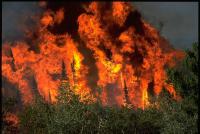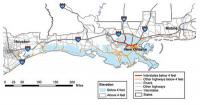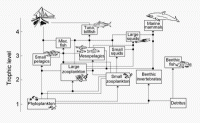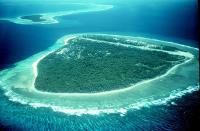-
Wildfires may double erosion across a quarter of western U.S. watersheds by 2050

Wildfires, which are on the rise throughout the west as a result of prolonged drought and climate change, can alter soil properties and make it more vulnerable to erosion. A new study shows that the increase in wildfires may double soil erosion in some western United States by 2050, and all that dirt ends up in streams, clogging creeks and degrading water quality.
-
-
Study: Persian Gulf could experience deadly heat
Detailed climate simulation shows that the Persian Gulf region would likely cross the threshold of survivability unless mitigation measures are taken. That tipping point involves a measurement called the “wet-bulb temperature” which combines temperature and humidity, reflecting conditions the human body could maintain without artificial cooling. That threshold for survival for more than six unprotected hours is 35 degrees Celsius, or about 95 degrees Fahrenheit, according to recently published research (the equivalent number in the National Weather Service’s more commonly used “heat index” would be about 165 F). The researchers say that hot summer conditions that now occur once every twenty days or so “will characterize the usual summer day in the future.”
-
-
Deadly extreme weather events to intensify, become more frequent over the next 50 years
European heat wave of 2003, during which 35,000 people died. It was the most extreme event of its kind since 1500 AD. In May 2015, India was struck by a severe heat wave that killed more than 2,500 people. “Heat waves that [were once] expected to occur twice a century [are now], in the early 2000s, expected to occur twice a decade. Human influence has very likely at least doubled the likelihood of such an event,” says one expert.
-
-
Climate change will reshape global economy: Study
Unmitigated climate change is likely to reduce the income of an average person on Earth by roughly 23 percent in 2100, according to estimates contained in a new study. The findings indicate climate change will widen global inequality, perhaps dramatically, because warming is good for cold countries, which tend to be richer, and more harmful for hot countries, which tend to be poorer. In the researchers’ benchmark estimate, climate change will reduce average income in the poorest 40 percent of countries by 75 percent in 2100, while the richest 20 percent may experience slight gains.
-
-
September 2015, and January-September 2015, the warmest on record
A new report from the National oceanic and Atmospheric Administration (NOAA) finds that September 2015 was the warmest month on record, with average temperature across global land and ocean surfaces reaching 1.62°F (0.90°C) above the twentieth century average. The year-to-date temperature across global land and ocean surfaces was 1.53°F (0.85°C) above the twentieth century average. This was the highest for January–September in the 1880–2015 record.
-
-
U.S. should lead climate change fight to bolster global stability: U.S. defense, diplomacy leaders
Forty-eight former U.S. leaders, both Republicans and Democrats – among them secretaries of state and defense, national security advisers, leaders of the intelligence community, diplomats, generals in all four branches of the armed services, senators, and members of the House of Representatives – have published an open letter in the Wall Street Journal which called on U.S. political and business leaders to “think past tomorrow” and lead the fight on climate change. The U.S. security establishment has long recognized the threat posed by climate change to U.S. national security, defining climate change as a “threat multiplier,” adding fuel to conflicts. Security experts and military leaders no longer regard climate change as only a threat multiplier, but rather as s serious danger on its own – with droughts, sea-level rise, food shortages, and extreme weather events triggering migration and armed conflicts.
-
-
California’s future: More frequent and more severe droughts and floods
In the future, the Pacific Ocean’s temperature cycles could disrupt more than just December fishing. A new study suggests that the weather patterns known as El Nino and La Nina could lead to at least a doubling of extreme droughts and floods in California later this century.
-
-
Philippines coastal areas go underwater due to sea level rise
More than 167,000 hectares of Philippines coastland — about 0.6 percent of the country’s total area — are projected to go underwater in, especially in low-lying island communities, according to research by the University of the Philippines. Low-lying countries with an abundance of coastlines are at significant risk from rising sea levels resulting from global warming. According to data by the World Meteorological Organization, the water levels around the Philippines are rising at a rate almost three times the global average due partly to the influence of the trade winds pushing ocean currents. On average, sea levels around the world rise 3.1 centimeters every ten years. Water levels in the Philippines are projected to rise between 7.6 and 10.2 centimeters each decade.
-
-
Managing urban stormwater runoff better
As meteorologists monitor the El Nino condition currently gaining strength in the Pacific Ocean, Californians look with hope to the much-needed rain and snow it could yield. But if Californians are going to make the most of the precipitation, they need to put a LID on it. LIDs, or low-impact development technologies, mimic pre-urban stream functions. Examples are green roofs that absorb and evapotranspire rainfall; rainwater tanks attached to homes and other buildings; and permeable pavement for roads, driveways and parking lots. Rainwater could even be used in the home for toilet flushing and laundry.
-
-
IPCC projections “wildly over optimistic”: Climate expert
As a new chairman is appointed to the Intergovernmental Panel on climate Change (IPCC), one climate expert has said headline projections from the organization about future warming are “wildly over optimistic.” The expert says that IPCC claims that “global economic growth would not be strongly effected” are unrealistic and that if we are to meet the 2°C warming target, wealthy and high emitting individuals will need to make dramatic cuts in the energy they use and in the material goods they consume at least until the transition away from fossil fuels is complete.
-
-
Sea level rise dooms Miami, New Orleans

Say goodbye to Miami and New Orleans. No matter what we do to curb global warming, these and other beloved U.S. cities will sink below rising seas, according to a new study. “In our analysis, a lot of cities have futures that depend on our carbon choices but some appear to be already lost,” says one of the study’s authors. “And it is hard to imagine how we could defend Miami in the long run.” An online tool shows which U.S. cities may face “lock-in dates beyond which the cumulative effects of carbon emissions likely commit them to long-term sea-level rise that could submerge land under more than half of the city’s population,” said the study.
-
-
Global marine analysis: Food chain collapse likely

A world-first global analysis of marine responses to climbing human CO2 emissions has painted a grim picture of future fisheries and ocean ecosystems. Marine ecologists say the expected ocean acidification and warming is likely to produce a reduction in diversity and numbers of various key species that underpin marine ecosystems around the world. The researchers found that there would be “limited scope” for acclimation to warmer waters and acidification. Very few species will escape the negative effects of increasing CO2, with an expected large reduction in species diversity and abundance across the globe.
-
-
DYI experiment demonstrates the physics of climate change for students

There are two main causes of rising sea levels — thermal expansion and melting land-based ice. Thermal expansion is responsible for most of the rising sea levels during the past century, but an increasing amount of rising levels into the future will be due to the melting Greenland and Antarctic ice sheets, as well as melting glaciers across the globe, especially the Himalayas, experts say. The rising sea level is a global phenomenon and will affect all coastal cities, but some places are more vulnerable than others. For example, the sea level on the North American Atlantic coast north of Cape Hatteras is rising three to four times faster than the global average, which has been attributed to a reduction in the strength of the Atlantic Meridional Overturning Current.
-
-
To “see” climate change, check your thermometer

Scientists often use satellites, supercomputers, or high-tech arrays of instruments to show how the climate is changing. But now researchers have shown how climate change can be visible, even at just one location, with the simplest instrument of all: a thermometer.
-
-
Climate change will soon make atolls in the Pacific, Indian oceans uninhabitable

More than half a million people live on atolls throughout the Pacific and Indian Oceans. A new study shows that the combined effect of storm-induced wave-driven flooding and sea level rise on island atolls may be more severe and happen sooner than previous estimates of inundation predicted by passive “bathtub” modeling for low-lying atoll islands, and especially at higher sea levels forecasted for the future due to climate change.
-
- All
- Regional
- Water
- Biometrics
- Borders/Immig
- Business
- Cybersecurity
- Detection
- Disasters
- Government
- Infrastructure
- International
- Public health
- Public Safety
- Communication interoperabillity
- Emergency services
- Emergency medical services
- Fire
- First response
- IEDs
- Law Enforcement
- Law Enforcement Technology
- Military technology
- Nonlethal weapons
- Nuclear weapons
- Personal protection equipment
- Police
- Notification /alert systems
- Situational awareness
- Weapons systems
- Sci-Tech
- Sector Reports
- Surveillance
- Transportation
Advertising & Marketing: advertise@newswirepubs.com
Editorial: editor@newswirepubs.com
General: info@newswirepubs.com
2010-2011 © News Wire Publications, LLC News Wire Publications, LLC
220 Old Country Road | Suite 200 | Mineola | New York | 11501
Permissions and Policies
Editorial: editor@newswirepubs.com
General: info@newswirepubs.com
2010-2011 © News Wire Publications, LLC News Wire Publications, LLC
220 Old Country Road | Suite 200 | Mineola | New York | 11501
Permissions and Policies
